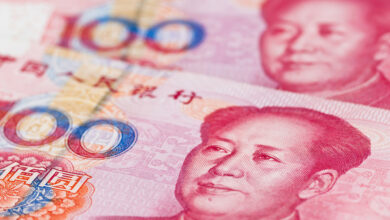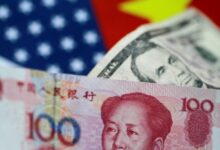Rising sol: Peru’s currency at year-high after shaking off protest impact

FILE PHOTO: A money changer holds Peruvian Sol bills at a street in downtown Lima, Peru, December 15, 2017. REUTERS/Mariana Bazo
Copper
-0.91%
Add to/Remove from Watchlist
Add to Watchlist
Add Position
Position added successfully to:
Please name your holdings portfolio
Type:
BUY
SELL
Date:
Amount:
Price
Point Value:
Leverage:
1:1
1:10
1:25
1:50
1:100
1:200
1:400
1:500
1:1000
Commission:
Create New Watchlist
Create
Create a new holdings portfolio
Add
Create
+ Add another position
Close
By Marco Aquino
LIMA (Reuters) — In a country shaken by years of political volatility, Peru’s national currency has emerged as a mainstay of relative stability among Latin American foreign exchange markets, reaching its strongest level in a year this week.
After taking a hit during the nearly two-year presidency of Pedro Castillo, the Peruvian sol is bouncing back just months after his removal and subsequent protests that briefly stifled the economy of the world’s second largest copper producer.
For the third straight day Thursday, the sol had its best showing since May 2022, trading at 3.665 soles per dollar, data from the central bank and traders showed.
Latin America’s main currencies have strengthened sharply in recent months, like Mexico’s peso, which hit a five-year high this week.
Peru’s currency, however, has not deviated much in value since 2000 and it is up some 3% so far in 2023 from its closing price at the end of December.
«Since the beginning of the century, we have depreciated something like 6% (…) while other currencies have depreciated by 50%, 100% or 150%,» the head of Peru’s central bank Julio Velarde said Wednesday at an event launching a commemorative coin.
In this context, «the sol is one of the most stable currencies in the region among large and medium-sized countries,» Velarde said.
Of Peru’s ten presidents this century, most have respected free market policies with rigid fiscal discipline. This allowed the economy to enjoy record growth rates for years, accumulate large net reserves and have a currency market that moves freely with supply and demand.
In this context, Peru’s central bank has only intervened in the market by buying or selling dollars or financial instruments to mitigate the sol’s volatility.
«What has been shown in 20 or 30 years is that the sol is a currency that guarantees value recovery, which is why Peru has more or less 40% of its debt in soles,» Economy Minister Alex Contreras said at a recent event.





